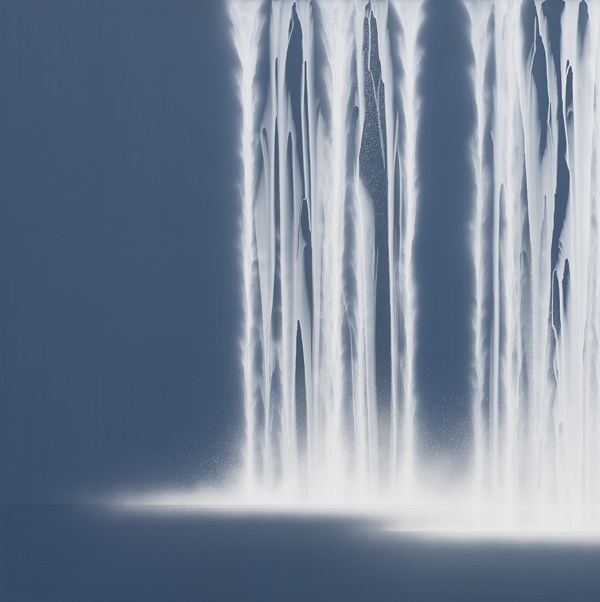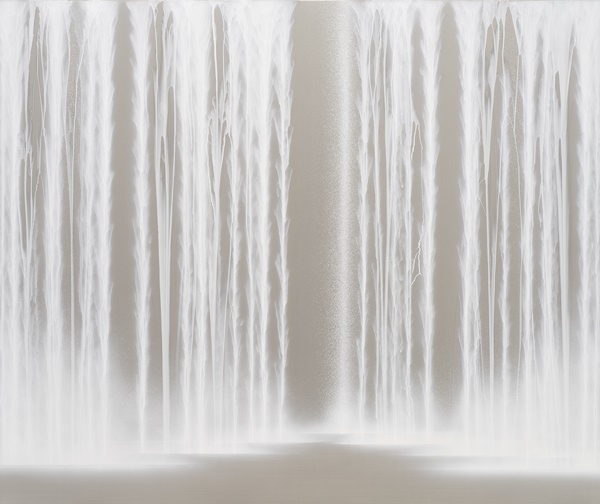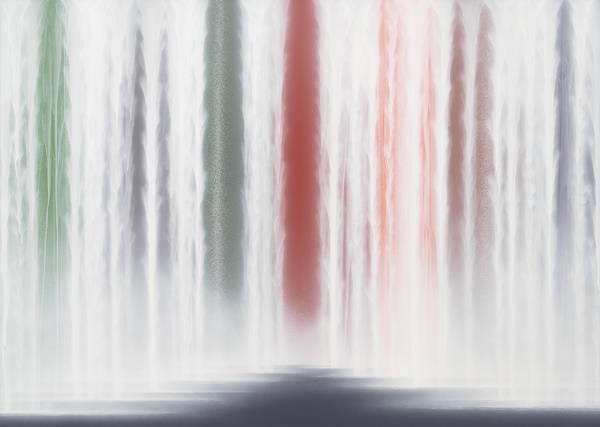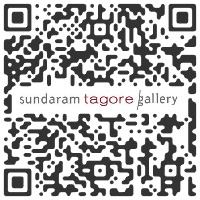Between Movement and Stillness
Hiroshi Senju

SUNDARAM TAGORE
5 Lock Road 01-05 Gillman Barracks Singapore 108933tel +65 6694 3378 e-mail:
March 8 > April 27, 2024




Hiroshi Senju, Waterfall, 2024, pigments on Japanese mulberry paper mounted on board, 57.3 x 57.3 inches/145.5 x 145.5 cm


Hiroshi Senju, Waterfall, 2024, platinum and pigments on Japanese mulberry paper mounted on board, 63.8 x 76.3 inches/162 x 194 cm


Hiroshi Senju, Waterfall on Colors, 2022, pigments on Japanese mulberry paper mounted on board, 63.8 x 89.5 inches/162 x 227 cm
We are pleased to present paintings by Hiroshi Senju (b. 1959, Tokyo), best known for his monumental Waterfalls, which are in renowned museums and prominent public spaces across the globe.
This exhibition offers a compelling overview of Senju’s signature series, including monochromatic, fluorescent, multicolored, and platinum-pigment Waterfalls. The exhibition, which shines a light on the evolution and many nuances of his Waterfall works, follows a number of high-profile projects the artist has undertaken since his last solo exhibition in Singapore in early 2021.
Since then, Senju was been awarded the 77th Imperial Prize and the Japan Art Academy Prize, the youngest artist to be so honored, and was commissioned to create an immersive, site-specific fluorescent Waterfall installation for the Art Institute of Chicago. One of the artist’s multicolored Waterfalls was acquired by the Victoria & Albert Museum in London, where it is currently on view in the Toshiba Gallery of Japanese art, and most recently, he created two works for the American Embassy in Tokyo.
Senju has been exploring the sublime power of nature for more than thirty years. The falls, in his view, are a unifying symbol—a powerful example of a life-giving force that people everywhere can appreciate. “The natural world is a place of refuge and a common ground we share that transcends natural, cultural and ideological boundaries,” he says.
Senju’s decades-long preoccupation with waterfalls is an homage to planet earth. Although his deep respect for Japanese culture and traditions has given him a particular reverence for and aesthetic appreciation of nature’s qualities, he views these as collective values that unite humankind. As we continue to grapple with climate change, the visual immediacy of his falls are a potent reminder of the power of the natural world to evoke awe and wonder.
Senju created the Waterfalls on view using bespoke natural pigments produced in Japan as well as manmade pigments. His robustly physical process involves pouring pigments downward from the top of paintings mimicking the trajectory of gushing water. He also uses spray guns and airbrushes to create a sensation of mist. Standing before these paintings, the senses and imagination are activated—one can almost hear the rushing water and feel the dampness in the air. Their waters are emblematic of the continuous flow of life’s energy as well as the dichotomy between permanence and transformation, between movement and stillness.
This exhibition offers a compelling overview of Senju’s signature series, including monochromatic, fluorescent, multicolored, and platinum-pigment Waterfalls. The exhibition, which shines a light on the evolution and many nuances of his Waterfall works, follows a number of high-profile projects the artist has undertaken since his last solo exhibition in Singapore in early 2021.
Since then, Senju was been awarded the 77th Imperial Prize and the Japan Art Academy Prize, the youngest artist to be so honored, and was commissioned to create an immersive, site-specific fluorescent Waterfall installation for the Art Institute of Chicago. One of the artist’s multicolored Waterfalls was acquired by the Victoria & Albert Museum in London, where it is currently on view in the Toshiba Gallery of Japanese art, and most recently, he created two works for the American Embassy in Tokyo.
Senju has been exploring the sublime power of nature for more than thirty years. The falls, in his view, are a unifying symbol—a powerful example of a life-giving force that people everywhere can appreciate. “The natural world is a place of refuge and a common ground we share that transcends natural, cultural and ideological boundaries,” he says.
Senju’s decades-long preoccupation with waterfalls is an homage to planet earth. Although his deep respect for Japanese culture and traditions has given him a particular reverence for and aesthetic appreciation of nature’s qualities, he views these as collective values that unite humankind. As we continue to grapple with climate change, the visual immediacy of his falls are a potent reminder of the power of the natural world to evoke awe and wonder.
Senju created the Waterfalls on view using bespoke natural pigments produced in Japan as well as manmade pigments. His robustly physical process involves pouring pigments downward from the top of paintings mimicking the trajectory of gushing water. He also uses spray guns and airbrushes to create a sensation of mist. Standing before these paintings, the senses and imagination are activated—one can almost hear the rushing water and feel the dampness in the air. Their waters are emblematic of the continuous flow of life’s energy as well as the dichotomy between permanence and transformation, between movement and stillness.
ABOUT ARTIST : Hiroshi Senju New York-based painter Hiroshi Senju (b. 1958, Tokyo) is renowned worldwide for his sublime waterfall and cliff images, which are often monumental in scale. He combines a minimalist visual language rooted in Abstract Expressionism with elements of traditional Japanese painting.
Hiroshi Senju was the first Asian artist to receive an Honorable Mention Award at the Venice Biennale (1995), and has participated in numerous exhibitions including The New Way of Tea, curated by Alexandra Munroe, at the Japan Society and Asia Society, New York, 2002; Paintings on Fusuma at the Tokyo National Museum, 2003; and Frontiers Reimagined at the Venice Biennale, 2015. In 2021, Senju produced a monumental, site-specific fluorescent waterfall installation for the Art Institute of Chicago. It was on view for eight months in a gallery in the Asian wing designed by Pritzker Prize-winning architect Tadao Ando. The 50-foot wide folding screens are now part of the museum’s permanent collection. In 2023 two of the artist’s waterfall paintings were installed in the United States Embassy in Tokyo. Among his many honors, Senju was awarded the Foreign Minister’s Commendation from the Japanese government for contributions to art in 2017, and in the same year, was honored with the Isamu Noguchi Award.
Notable public installations include seventy-seven murals at Juko-in, a sub-temple of Daitoku-ji, a Zen Buddhist temple in Japan, and multiple monumental waterfalls at Tokyo International Airport (Haneda). The Benesse Art Site of Naoshima Island houses two large-scale installations.
The artist’s monumental cliff and waterfall paintings for the Kongobuji Temple at Koyasan—a UNESCO World Heritage Site and sacred Buddhist monument—traveled to museums throughout Japan before being consecrated and installed in 2020. Assouline released a lavish coffee-table volume featuring 100 color photographs documenting this historic project in 2022.
Senju’s work is in the permanent collections of the Victoria & Albert Museum, London; The Metropolitan Museum of Art and Brooklyn Museum, New York; the Los Angeles County Museum of Art and the Museum of Contemporary Art, Los Angeles; the Asian Art Museum, San Francisco; the Nelson-Atkins Museum of Art, Kansas City, Missouri; the Royal Ontario Museum, Toronto; the Museum of Modern Art, Toyama, Japan; the Yamatane Museum of Art, Tokyo; Tokyo University of the Arts; and the Kushiro Art Museum, Hokkaido. In 2009, Skira Editore published a monograph of his work titled Hiroshi Senju. The Hiroshi Senju Museum Karuizawa in Japan opened in 2011. < > https://www.hiroshisenju.com
CITY :NEW YORK NY
COUNTRY :USA
 Hiroshi Senju
Hiroshi Senju 
Hiroshi Senju was the first Asian artist to receive an Honorable Mention Award at the Venice Biennale (1995), and has participated in numerous exhibitions including The New Way of Tea, curated by Alexandra Munroe, at the Japan Society and Asia Society, New York, 2002; Paintings on Fusuma at the Tokyo National Museum, 2003; and Frontiers Reimagined at the Venice Biennale, 2015. In 2021, Senju produced a monumental, site-specific fluorescent waterfall installation for the Art Institute of Chicago. It was on view for eight months in a gallery in the Asian wing designed by Pritzker Prize-winning architect Tadao Ando. The 50-foot wide folding screens are now part of the museum’s permanent collection. In 2023 two of the artist’s waterfall paintings were installed in the United States Embassy in Tokyo. Among his many honors, Senju was awarded the Foreign Minister’s Commendation from the Japanese government for contributions to art in 2017, and in the same year, was honored with the Isamu Noguchi Award.
Notable public installations include seventy-seven murals at Juko-in, a sub-temple of Daitoku-ji, a Zen Buddhist temple in Japan, and multiple monumental waterfalls at Tokyo International Airport (Haneda). The Benesse Art Site of Naoshima Island houses two large-scale installations.
The artist’s monumental cliff and waterfall paintings for the Kongobuji Temple at Koyasan—a UNESCO World Heritage Site and sacred Buddhist monument—traveled to museums throughout Japan before being consecrated and installed in 2020. Assouline released a lavish coffee-table volume featuring 100 color photographs documenting this historic project in 2022.
Senju’s work is in the permanent collections of the Victoria & Albert Museum, London; The Metropolitan Museum of Art and Brooklyn Museum, New York; the Los Angeles County Museum of Art and the Museum of Contemporary Art, Los Angeles; the Asian Art Museum, San Francisco; the Nelson-Atkins Museum of Art, Kansas City, Missouri; the Royal Ontario Museum, Toronto; the Museum of Modern Art, Toyama, Japan; the Yamatane Museum of Art, Tokyo; Tokyo University of the Arts; and the Kushiro Art Museum, Hokkaido. In 2009, Skira Editore published a monograph of his work titled Hiroshi Senju. The Hiroshi Senju Museum Karuizawa in Japan opened in 2011. < > https://www.hiroshisenju.com
CITY :NEW YORK NY
COUNTRY :USA
 Hiroshi Senju
Hiroshi Senju Date and hours artist presence :Saturday, March 9 3-5pm for an afternoon of art and conversation
Gallery Opening Hours : Tuesday - Saturday 11am - 7pm Sunday 11am - 6pm
mpefm SINGAPORE art press release

Gallery Opening Hours : Tuesday - Saturday 11am - 7pm Sunday 11am - 6pm
mpefm SINGAPORE art press release
QR of this press release
in your smartphone, tablet








